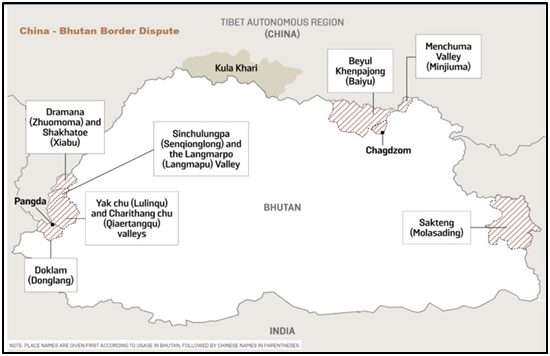Why in news?
- China and Bhutan held their 25th round of boundary talks in Beijing.
- Both the countries signed a Cooperation Agreement on the Responsibilities and Functions of the Joint Technical Team (JTT) on the Delimitation and Demarcation of the Bhutan-China Boundary.
- This advances their 3-Step Roadmap initiated in 2021 for border resolution, building on the positive momentum since their last talks in 2016.
What’s in today’s article?
- China - Bhutan Border Dispute
- News Summary
China - Bhutan Border Dispute

- Bhutan shares a 477 km-long border with China, which claims certain territories from Bhutan:
- In the north –Pasam-lung and Jakar-lung valleys; and
- Both of these places are culturally vital for Bhutan.
- In the west -Doklam, Dramana, and Shakhatoe, Yak Chu and Charithang Chu, and Sinchulungpa and Langmarpo valleys.
- These places are pasture-rich and strategically located in the Bhutan-India-China trijunction, lying precariously close to India’s Siliguri Corridor.
- In 2020, China made new claims on Bhutan’s East in the Sakteng sanctuary.
- Surprisingly, there has been no mention of Eastern Bhutan in the previous rounds of boundary negotiations held between the two countries.
- Hence, addition of Eastern Bhutan in the list of disputed territories has baffled Bhutan.
- This eastern sector of Bhutan has a large Bhutanese population, traditional Dzongs (Medieval fortified monastery) and two Bhutanese districts since time immemorial.
News Summary: China-Bhutan boundary talks and its significance
Why are the recent talks significant?
- The Boundary talks between Bhutan and China were held after a gap of seven years and indicate significant progress.
- Bhutan and the Tibetan Autonomous Region share a contiguous border to Bhutan’s north and west of about 470 km.
- Since 1984, Bhutan and China had held 24 rounds of talks to resolve the disputes until 2016.
- But the 25th round appeared to have been held up after the Doklam Standoff between Indian and Chinese armies in 2017, and then the COVID-19 pandemic in 2019-2021.
- However, the two sides used the pause to hold talks at other levels in rapid succession, especially after China threatened to open a new front for a border dispute to Bhutan’s east.
- Since then, the Expert Group of diplomats on both sides met in 2021 to agree on a 3-step roadmap, and the first boundary delimitation technical talks were held in August 2023.
What is the 3-Step Roadmap?
- Bhutan and China donot have diplomatic ties, as Bhutan has avoided diplomatic relations with all the United Nations Security Council permanent members.
- The 3-Step Roadmap involves:
- agreeing to the border on the table;
- then visiting the sites on the ground; and
- then formally demarcating the boundary.
Why India is keeping an eye on the developments related to China-Bhutan boundary dispute?
- For India, given the breakdown in its ties with China over the standoff at the LAC from 2020, any hint of closer ties between China and Bhutan is a cause for worry.
- More specifically, New Delhi is watching the demarcation discussions over Doklam.
- Amongst the proposals China has placed on the table is an agreement to swap areas in Doklam under Bhutanese control with areas in Jakarlung and Pasamlung which China claims.
- This is significant as India views Chinese presence near Doklam as a major security concern close to the strategic Siliguri corridor.
- China has also staked claim to a wildlife sanctuary in Bhutan near the border with Arunachal.
- This assumes significance as, in December 2022, Indian and Chinese army troops clashed along the LAC in the Tawang Sector of Arunachal Pradesh.
- India’s worry is over China’s demand for full diplomatic relations with Bhutan, and opening an Embassy in Thimphu.
- Given India’s challenges with Chinese projects and funding in other neighbouring countries, any Chinese presence in a small country like Bhutan would be problematic.
- However, Bhutan’s leadership has thus far said that all decisions would consider India’s interests and has always consulted India on issues of concern.
What are the challenges in solving the border dispute between China and Bhutan?
- Bhutan-China border dispute is not a bilateral issue
- The first challenge is to see if China would be keen on discussing the trijunction areas with India.
- For this, China will have to shun its decades-old policy of treating the Bhutan-China border dispute as a bilateral issue and involve India as well.
- Increasing Chinese expansion in the Western disputed regions
- India has briefed and sensitised Bhutan of China’s increasing inroads on multiple occasions.
- Bhutan lacks the material capability and presence to avert these continuing intrusions. Despite this, it stays reluctant to seek more Indian assistance, fearing more Chinese assertiveness.
- China is keen on establishing diplomatic relations with Bhutan
- China’s solution to border disputes has often been inclusive of establishing diplomatic relations with Bhutan.
- Such demands from Beijing will only intensify as its tensions with the US and India increase.










